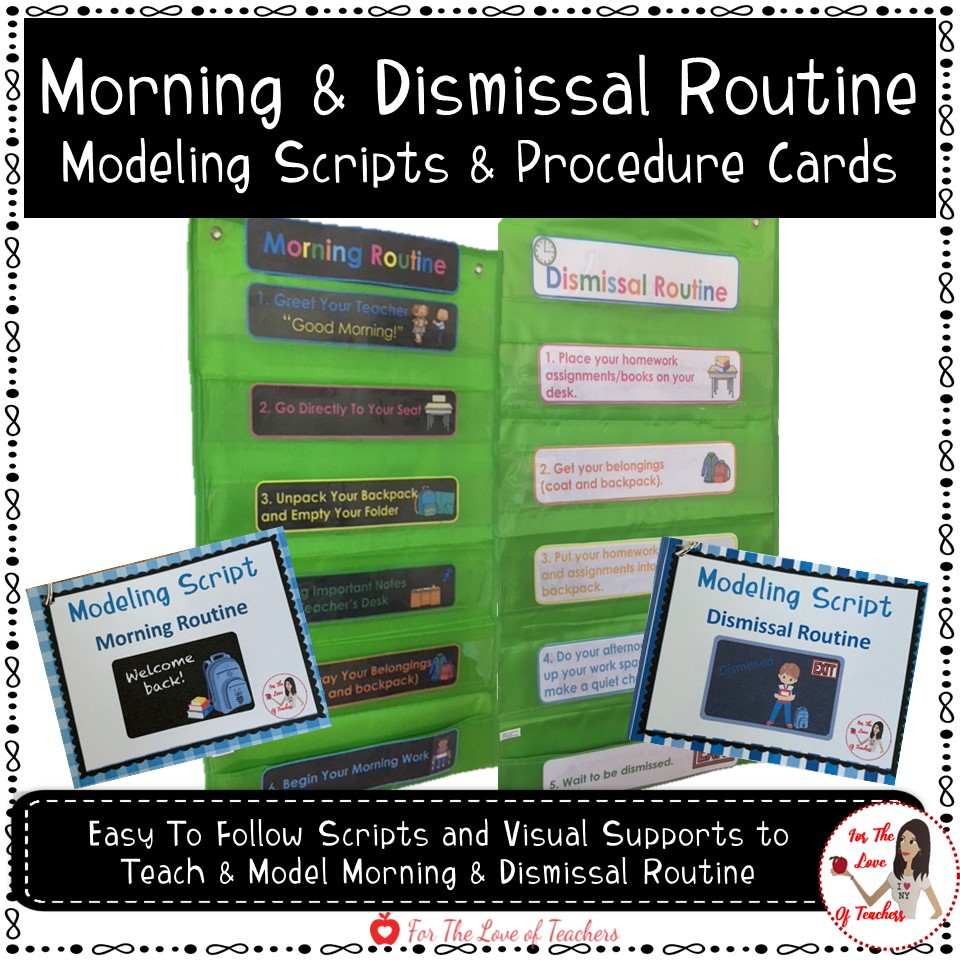Think about how many times teachers give directions per day. From the first period to the last period, within each subject, for each lesson and activity, and more or less in repetitions based on age and grade level. There is no doubt that giving directions is something teachers do all day, even in their sleep, but even more so, giving crystal clear directions is critical for strong classroom management. By making no assumptions that students already know, should know, or understand what is expected, is key in creating an environment that is conducive for teaching and learning.
One problem with giving directions, or the lack of for that matter, is assuming that your students already know what to do or what is expected of them. This is a common misconception in many classrooms and serves as a barrier. If you walk into an elementary classroom, most teachers are giving directions frequently in every way, shape, and form. Somewhere in middle or high school, this may go by the wayside as teachers assume that students know or should know what to do at their age/grade level. But when all students, and even adults, are given crystal clear directions it results in fewer repetitions and more productivity in completing the tasks at hand with success.
Giving Crystal Clear Directions
Giving crystal clear directions is using precise language to communicate what is expected. The directions are clear, concise, and specific. As a Responsive Classroom teacher, I teach, model and guide my students through practice so they know exactly what is expected. This is called interactive modeling. I find that many times that it’s not that students are intentionally choosing not to follow directions, but rather there is a lack of clarity when giving directions which results in misunderstandings and misinterpretations.
For example, I show my students exactly how to walk into my classroom each day. I list the steps on visual cards and post them in our classroom. I model what each step looks like and sounds like and allow my students to practice and give them feedback as they practice. This sets the expectations for exactly what our morning arrival routine should look like and sound like.
Arrival/Morning Routine
-
Greet your teacher
-
Go directly to your seat
-
Unpack your backpack and empty your folder
-
Hang up your belongings
-
Bring important notes to teacher’s desk (or designated area)
-
Begin your morning work
After the directions and expectations are crystal clear, modeled and practiced, students have no trouble with following our morning routine (see my editable morning routine procedure cards, morning routine script or both. It makes our mornings run so smoothly as we transition into class each day starting off on the right foot. (Need help with dismissal: Dismissal Routine Modeling Script & Procedure Cards.

Check this out here.
I do this for every daily routine in my classroom. Read more about this in my post, Classroom Management Time Saver: Systematizing All Daily Tasks.
Thoughtful Teacher, a classroom management model designed to transform the way teachers manage their students, compares crystal clear directions to implied directions. Here are some helpful examples.
Crystal Clear Directions |
Implied Directions |
|
|
|
|
|
|
(Thoughtful Teacher: 10 Steps to Effective Classroom Management, p. 13)
See the difference in delivery and clarity?
Visual, Verbal & Written
Sometimes when directions are given, we miss some or misinterpret them. Delivering crystal clear directions in a variety of ways supports your different types of learners. Try this:
-
Say/explain/show the directions and have a student repeat/show them back to the class. This is good for both your visual and auditory learners.
-
Follow up by answering any questions students may have to eliminate misunderstandings or misinterpretations.
-
Post directions on a board or print the directions on a handout for reference. I do this for my visual learners who need to see each step in the process and to refer back to. Some students like to check off or cross out each step as they go.
-
Give fewer, crystal clear directions for younger students. They can’t follow too many steps in a process.
-
Always give crystal clear directions to older students. They need it too.
Giving crystal clear directions will eliminate behavior problems and is a classroom management time saver. More students are less frustrated and are on task. You’ll have fewer interruptions and more minutes for teaching and learning. A win-win! Give it a try and see the difference it makes in your overall classroom environment.
If you think that Thoughtful Teacher is for you because you need or want support in classroom management then reach out to your admin about the benefits of Thoughtful Teacher. Don’t be afraid to ask for support or to educate them! For more information visit www.thoughtfulteacher.org. If you have any questions, you can contact info@thoughtfulteacher.org.
Follow me to be notified when new resources are uploaded to the Shop and join the email list to receive the latest and greatest updates, posts, and some awesome freebies!
If you like it, then pin it,



Christine Weis is a passionate educator, classroom management coach, wife, and mom of two busy boys. She enjoys teaching, writing, and creating resources for teachers.





Great idea I was a preschool aid and used it all the time. This was a part of our circle time talks when we needed a little reminding of our classroom rules.
Yes…especially helpful and necessary for little ones! Thanks for reading!
Christine at For The Love of Teachers
I agree Christine I used this plan when I worked in preschool. It always helped in management of my preschool class.
Giving crystal clear directions that are brief and use consistent language are so important for little ones. Thanks for reading!
Christine at For The Love of Teachers
Worth the read…Nicely written! Offering clear directions is not only necessary when it comes to leading children but everywhere…office, social, team etc.
Thank you! Yes,great point! Crystal clear communication is necessary at the home and office too! Thanks for reading!
Christine at For The Love of Teachers
That’s a good one! First you have to know it to later implement it:) Good stuff for back to school I think.
Thank you! Thanks for reading!
Christine at For The Love of Teachers
I have come across so many ineffective teachers, they fail to provide crystal clear directions. I love how you laid out all points as to how to go about giving clear directions. This will be so helpful to the teachers.
I completely agree. Crystal clear communication is difficult for many and can make or break you as a teacher (or manager). I hope it helps many teachers. Thanks for reading!
Christine at For The Love of Teachers
This is a great resource to share with teachers (and really, even at home with your own kids!) Love that you included examples too.
-Jennifer
https://maunelegacy.com
It really is! I’m not sure if many teachers even know about this site and the variety of benefits and resources it provides. One teacher even challenged my post saying the site’s resources began at middle school. Not the case! It’s such a great resource for ALL teachers. Thanks for reading!
Christine at For The Love of Teachers
Offering clear directions can be a great idea when it comes to leading children to do things throughout the day.
Yes…it really is a great classroom management tool! Thanks for reading!
Christine at For The Love of Teachers
no! I know I do not but this is all such great advice! I have an assistant at the salon & it’s something I have to be really conscious to do… especially because I’m not naturally a manager of people!
Maybe you could try practicing giving your assistant crystal clear directions. I bet it will improve your overall relationship and work environment. Thanks for reading!
Christine at For The Love of Teachers
I am not a school teacher, but I am a group fitness instructor. You are so correct in that sometimes we can think we are giving clean directions simply because we already know what it is we are wanting to communicate! You really do have to gauge your audience and think about what they need from your as a communicator to best serve their needs as a teacher!
Such a great point! Giving crystal clear directions is all about crystal clear communication. Sometimes there is gap in what we want to say, are trying to say and what we actually say. Definitely a great idea to gauge and know your audience. Thanks for reading!
Christine at For The Love of Teachers
Thank you for this post! My son is 2 and he can follow basic directions already but he never follows them how I expect him to do so. I should give him more specific directions in order to get the type of response I’m looking for. You’re absolutely right! Spot on!
You’re welcome! Since your son is only two years old, give only a few, brief directions. Be consistent with the language, the words you use, and what you ask of him. I have a two year old also and he listens better than my almost 8 year old son. My older son chooses not to follow directions. The joys of parenting…lol. Thanks for reading!
Christine at For The Love of Teachers
Very interesting and well written. I never really thought about how being this exact can help kids with a routine.
Thank you! It really does make a difference, for kids of all ages. Thanks for reading!
Christine at For The Love of Teachers
I agree that giving crystal clear directions is essential to avoid misunderstandings and confusion. I, in particular, appreciate when teachers (and in my case, managers) give crystal clear directions. When one doesn’t, I personally find that I either misinterpret what they said or, if they are giving too much information at once, I can’t follow what they are saying anymore. I like how you give your students crystal clear instructions, and that you emphasize not giving too many instructions to younger students.